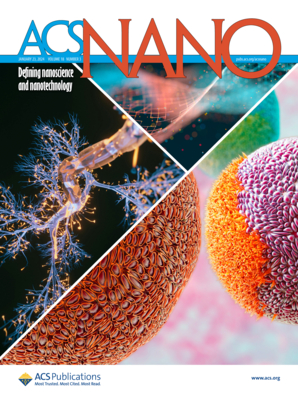Multitwinned Ice Nanocrystals
IF 15.8
1区 材料科学
Q1 CHEMISTRY, MULTIDISCIPLINARY
引用次数: 0
Abstract
Multitwinned nanocrystals are commonly found in substances that preferentially adopt tetrahedral local arrangements, but not yet in water crystals. Ice nanocrystals are pivotal in cloud microphysics, and their surfaces become increasingly prominent in determining structure as crystal size decreases. Nevertheless, discussions on nanocrystal structures have predominantly centered on ice polymorphs observed in bulk: hexagonal (Ih), cubic (Ic), and stacking-disordered (Isd) ices. Here, we demonstrate, through molecular dynamics (MD) simulations, that decahedral and icosahedral nanocrystals form from liquid water droplets of a few nanometers in size without violating the ice rule. The brute force spontaneous crystallization is conducted using the mW model, and the thermodynamic stability is examined using the TIP4P/Ice model. During the crystallization process, the formation of twin boundaries precedes the emergence of centers exhibiting 5-fold and icosahedral symmetry. The free energy calculation suggests the icosahedron has comparable stability with ice Ih nanocrystal. The frequent occurrence of these unreported ice nanocrystals aligns with the fact that natural polycrystalline snow crystals predominantly display a 70.5-degree angle between the Ih c-axes of adjacent branches. Moreover, we show that the formation of multitwinned ice nanocrystals is enhanced within a fullerene, providing a potential avenue for experimental observations.

多孪晶冰纳米晶体
多孪晶纳米晶体通常存在于优先采用四面体局部排列的物质中,但在水结晶中尚未发现。冰纳米晶体在云微观物理中起着举足轻重的作用,随着晶体尺寸的减小,其表面在决定结构方面也变得越来越突出。然而,有关纳米晶体结构的讨论主要集中在块状冰的多晶体上:六方冰(Ih)、立方冰(Ic)和堆积有序冰(Isd)。在这里,我们通过分子动力学(MD)模拟证明,十面体和二十面体纳米晶体是由几纳米大小的液态水滴形成的,并不违反冰的规则。利用 mW 模型进行了蛮力自发结晶,并利用 TIP4P/Ice 模型检验了热力学稳定性。在结晶过程中,孪晶边界的形成先于呈现 5 倍对称性和二十面体对称性的中心的出现。自由能计算表明,二十面体具有与冰 Ih 纳米晶体相当的稳定性。这些未被报道的冰纳米晶体的频繁出现与天然多晶雪晶体主要显示相邻分支的 Ih c 轴之间存在 70.5 度夹角的事实相吻合。此外,我们还证明了在富勒烯内部多孪晶冰纳米晶体的形成会得到增强,这为实验观察提供了潜在的途径。
本文章由计算机程序翻译,如有差异,请以英文原文为准。
求助全文
约1分钟内获得全文
求助全文
来源期刊

ACS Nano
工程技术-材料科学:综合
CiteScore
26.00
自引率
4.10%
发文量
1627
审稿时长
1.7 months
期刊介绍:
ACS Nano, published monthly, serves as an international forum for comprehensive articles on nanoscience and nanotechnology research at the intersections of chemistry, biology, materials science, physics, and engineering. The journal fosters communication among scientists in these communities, facilitating collaboration, new research opportunities, and advancements through discoveries. ACS Nano covers synthesis, assembly, characterization, theory, and simulation of nanostructures, nanobiotechnology, nanofabrication, methods and tools for nanoscience and nanotechnology, and self- and directed-assembly. Alongside original research articles, it offers thorough reviews, perspectives on cutting-edge research, and discussions envisioning the future of nanoscience and nanotechnology.
 求助内容:
求助内容: 应助结果提醒方式:
应助结果提醒方式:


